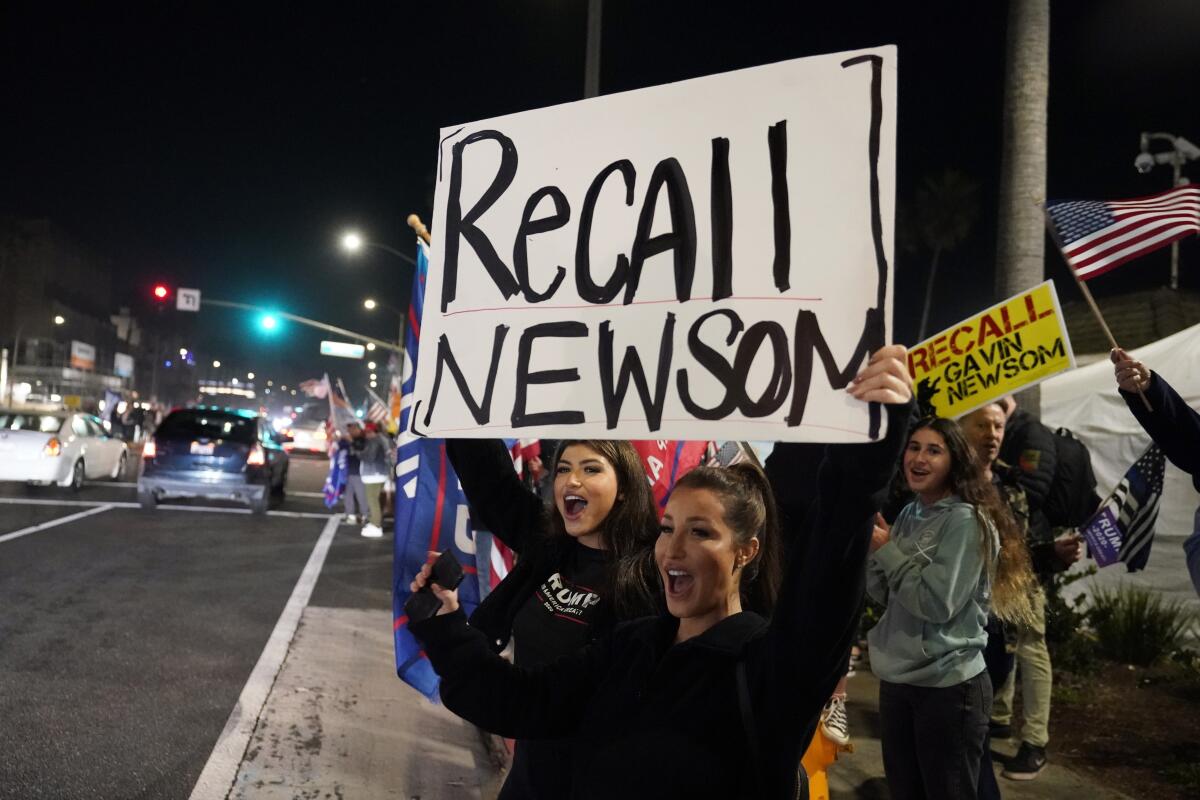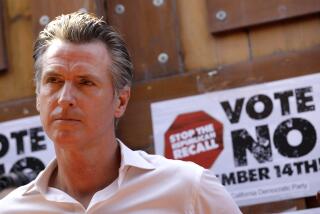Column: If Republicans succeed in ousting Newsom, recalls will become their go-to strategy

- Share via
In California, there are almost twice as many registered Democrats as Republicans.
No Republican has been elected to the U.S. Senate from California since 1988. Nor, with one exception (which we’ll come back to in a moment), has there been a Republican governor elected here since 1994. The last GOP presidential candidate to win the state was George H.W. Bush in 1988.
For California Republicans, the decline in influence over the last three decades has been long, slow and frustrating. Their party is as weak as it has ever been in the state.
So it’s no wonder they’ve turned to the recall — that dubious and deeply flawed vestige of California’s turn-of-the-20th-century romance with direct democracy. They hope it will once again open a back door to power, propelling them to victory in a race for governor despite their obvious numerical disadvantages.
After all, they figure, it worked in 2003 when, for the first time in California history, a gubernatorial recall qualified for the ballot — and Gov. Gray Davis, a Democrat, was summarily booted from office in the middle of his term and replaced with Arnold Schwarzenegger, a Republican.
Now, Republicans have qualified a second recall, this time challenging embattled Gov. Gavin Newsom.
But be very clear about this: If the recall is successful again, it will become the go-to strategy for Republicans for years to come.
It’s easy to see why the GOP likes our ridiculous recall system: It is a wild card, allowing for all sorts of otherwise improbable outcomes — like installing a governor from a party that represents only 1 in 4 registered voters. That’s possible because of absurd recall procedures, which allow a candidate to win with substantially less than 50% of the vote.
“One of the rules of political physics is that in chaos lies opportunity,” says Dan Schnur, a former GOP political strategist who teaches at USC and UC Berkeley.
Garry South, who was Gray Davis’ chief strategist, says it has become obvious the GOP can’t win a Democrat-versus-Republican general election, so Republicans are seeking an alternative path to power. “They did it with Davis,” he says. “And they’re hoping to do it with Newsom.”
Ousting Newsom is a long shot, to be sure, given that his favorable ratings are much higher than Davis’ were 18 years ago and that the state is even more Democratic today. But it is far from impossible.
And the recall process is problematic, to say the least.
For one thing, this special election could cost taxpayers $100 million to $400 million, by some estimates, at a time when we have far better things to be spending money on.
For another thing, there’s just no need for it now, when the next regularly scheduled election for governor is in 2022. Why not give a guy a chance to serve out his term and see what he can do?
When the recall was added to the California Constitution in 1911, proponents expected it to be used sparingly, only in cases of egregious misbehavior. But, in fact, there are no limitations on it. Any elected official can be tossed out any time for any reason. More than a dozen other states allow recalls, but many require specific criteria to be met, such as malfeasance by an elected official or conviction of a crime or incompetence. Not California.
Here’s another big problem with the recall: It’s way too easy to become a candidate. Would-be replacement candidates only need to pay a filing fee of about $4,200 (or turn in 7,000 valid signatures) — and voila! There’s no winnowing process, like a primary. The ballot will have two questions: whether voters want to recall Newsom, and who they want to be the next governor if the recall succeeds. The field of possible candidates can be huge, and Newsom cannot run to replace himself.
In 2003, Californians were asked to vote on whether Davis should keep his job, then given a choice of 135 replacement candidates on the ballot, more than in any California governor’s race in history. Among them were a pornographer, a sumo wrestler and a former child TV star, in addition to the star of action movies who won the race. The ballot also included candidates named “Robert Dole” and “Edward Kennedy.”
Under California’s recall process, bizarre scenarios are always possible. Newsom, for example, could be removed from office by a margin of, say, 51% to 49%. He could then be replaced by someone who gets only 35% or even 25% of the vote, since the vote will be split among dozens and dozens of candidates.
In that scenario, we’d have a new governor supported by many fewer people than supported the one ousted from office.
But politics is politics and the Republicans are pressing forward, calling on voters to “dethrone and recall” the man they now call “King Newsom.”
For them, the recall offers opportunities. Perhaps turnout will be low. Perhaps those who show up will be disproportionately Newsom haters.
Maybe by then Newsom will be facing a new virus surge or we’ll have a bad wildfire season or he’ll have gone to the French Laundry again.
Maybe having a Democrat on the replacement ballot will encourage Democrats to vote in favor of recall.
Or maybe there’ll be no Democrat on the replacement ballot and, in the event Newsom is recalled, there won’t even be an option of voting for one.
All bets are off.
I see why this kooky system is appealing to Republicans. But it’s not a working system. A higher bar needs to be set to qualify a recall. The filing fee (and signature requirements) to qualify candidates for the replacement ballot should also be higher.
Perhaps California should set standards for when a recall is appropriate, rather than allowing it whenever voters feel disgruntled.
It’s understandable that Republicans want to be back in the game in California. But undoing legitimate elections through the recall isn’t the way to get there.
@Nick_Goldberg
More to Read
A cure for the common opinion
Get thought-provoking perspectives with our weekly newsletter.
You may occasionally receive promotional content from the Los Angeles Times.










